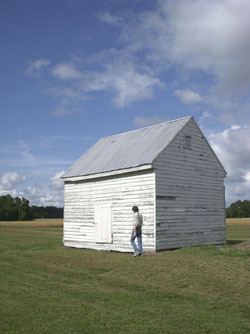Two men in flowing white gowns wave their arms as they stare across the ocean, a man moves in and out of focus in front of a bright background, rock climbers, a blue bus, the frame of a house left unfinished, a teepee, a family, a music festival.
These images with little or no sound are the work of a Lopezian artist and have been exhibited in New York City.
The artwork drew attention in January from the New York Times Style Magazine blog.
The featured artists, Colin Snapp, of Lopez Island and Daniel Turner of Virginia, show their work at a Greenpoint studio in New York City. They recently began exhibiting collaborative work under the name Jules Marquis.
According to the Times, the artists “take aspects of globalized culture and consumerism and trickle them down to a rural level.”
You might ask, how exactly does one do this?
Snapp works primarily in the medium of video, which acts as a jumping point for stills, sculptural and performance art.
The New York Times blog cites the filming of an ode to NBC in a field (shown on page 6) and having small-town Little Leaguers pace around a New York gallery muttering ‘‘good game’’ to one another, as an example of the Jules Marquis ethos.
“The idea behind these works is simple and ties into the fact that both of us [Turner and I] have spent our lives divided between rural locations and major cities,” Snapp said.
Or take the nonprofit art gallery Turner and Snapp have created, which resembles a big-city-gallery on the inside, but on the outside it’s a shed in a field in rural Virginia.
“Originally the space was used as his [Turner’s] studio,” Snapp said. “The transformation from studio to gallery was very organic and was instigated out of our frustration towards the presentation of contemporary art.”
The space named Jericho Ditch, after a local logging canal, gives artists living in New York or abroad a rural setting that city living can’t provide.
The Lopezian artist explains his work process as relying heavily on intuition and shooting lots of video.
“The things I did not intentionally shoot seem to influence my work more than the planned project,” said Snapp. “Most works are based on aspects of travel and the juxtaposition of global contrast.”
Snapp spent the first 18 years of his life on Lopez. In his early years he worked on documentaries and landscape paintings.
“The early documentary work was informed by my love of skateboarding, but in high-school the work began to take a more objective perspective and investigate the eccentric qualities of rural living and fringe culture as a whole,” Snapp said.
After high school he attended the San Francisco Art Institute and in 2006 received a Bachelor of Fine Arts in filmmaking.
Two years later he moved to New York and began exhibiting his work in New York galleries and now at Jericho Ditch.
He does occasionally visit the Pacific Northwest.
“I recently took a trip to the Hoh Rain Forest [in the Olympic National Park] to gather material for an upcoming exhibition,” said Snapp. “I still feel the influence of growing up in that region and feel it has always informed my work in one way or another.”
Snapp and Turner have two shows opening in June: at Jericho Ditch and at Martos Gallery in New York.



